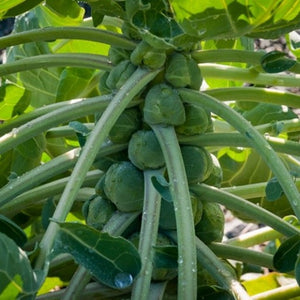- Hardiness Zone: 2-11 Biennial Typically Grown As An Annual
- Grow As Microgreens: Long Island Brussels Sprout Microgreens
Seed Depth: 1/4–1/2 inch
Seed Spacing: 18–24 inches
Row Spacing: 24–36 inches
Sunlight: Full sun to partial shade
Days to Sprout: 5–10 days
Days to Maturity: 85–110 days
Growth Habit: Upright
Sunlight: Choose a location that receives full sun for at least 6-8 hours a day.
Soil: Prefers well-drained, fertile soil with a pH between 6.5 and 7.5. Amend the soil with compost or well-rotted manure to enhance fertility and drainage.
When to Plant: Brussels sprouts are a cool-season crop that should be planted in early spring or late summer for a fall or early winter harvest. Start seeds indoors 6-8 weeks before the last expected frost date for a spring crop, or sow seeds directly in the garden in late summer for a fall crop.
Starting Indoors: Sow seeds 1/4 inch deep in seed-starting mix. Keep the soil moist and maintain a temperature of 65-75°F (18-24°C). Transplant seedlings outdoors when they have 4-6 true leaves and the danger of frost has passed.
Direct Sowing: Sow seeds directly in the garden 1/2 inch deep and 3 inches apart in rows spaced 24-36 inches apart. Thin seedlings to stand 18-24 inches apart once they are a few inches tall.
Succession Planting: Not typically needed; plants produce over an extended period once mature.
Watering: Keep the soil consistently moist but not waterlogged. Water Brussels sprouts regularly, especially during dry periods. Mulch around the plants to retain soil moisture and suppress weeds.
Fertilization: Brussels sprouts are heavy feeders. Apply a balanced fertilizer or compost at planting time and again when the plants are 3-4 weeks old. Side-dress with compost or a balanced fertilizer as the plants grow to support their nutrient needs.
Mulching and Weeding: Apply a layer of mulch around the plants to retain soil moisture, suppress weeds, and keep the soil temperature consistent. Hand-pull weeds carefully to avoid disturbing the shallow roots of the Brussels sprouts.
Pruning: Remove yellowing lower leaves as sprouts mature to direct energy toward sprout production.
Staking: As the plants grow taller, they may need staking to support their weight and prevent them from toppling over. Use garden stakes or other supports to keep the plants upright.
Pest and Disease Management: Watch for common pests such as aphids, cabbage worms, and flea beetles. Use organic pest control methods like neem oil, insecticidal soap, or hand-picking to manage infestations. Practice crop rotation and ensure good air circulation to prevent fungal diseases like downy mildew and clubroot.
When to Harvest: Brussels sprouts are typically ready to harvest 85-110 days after planting. Harvest when the sprouts are firm, about 1-2 inches in diameter, and before they begin to open.
How to Harvest: Start harvesting the lower sprouts first, as they mature sooner. Use a sharp knife to cut the sprouts from the stalk. You can also remove the leaves below the harvested sprouts to encourage further growth. Continue harvesting upward as the sprouts mature.
Storing Fresh Brussels Sprouts: Freshly harvested Brussels sprouts can be stored in the refrigerator for up to a week. Place the sprouts in a plastic bag or container to retain moisture. For longer storage, Brussels sprouts can be blanched and frozen.
Why You’ll Love It
Heirloom Classic: Introduced in the 1890s and still a garden favorite for flavor and yield.
Cold-Hardy Performer: Thrives in cool weather and improves in flavor after light frosts.
Compact Plants: Ideal for smaller gardens, raised beds, or tight row spacing.
High Yield: Produces up to 100+ sprouts per plant with proper care.
Plant Characteristics
Height: 20–24 inches
Growth Habit: Upright stalk with spiraled leaf arrangement and sprouts along the stem
Sprout Type: Small, tightly packed green sprouts that mature from the bottom up
Days to Maturity: 90–100 days
Hardiness: Cool-season biennial grown as an annual
Flavor and Culinary Uses
Flavor: Nutty, earthy, and slightly sweet — especially after a frost
Culinary Uses: Perfect for roasting, sautéing, steaming, or shredding into slaws and salads
Companion Planting Tips
Good Companions: Onions, beets, carrots, and chamomile
Avoid Planting Near: Strawberries and pole beans
Bonus Benefit: Can be overwintered in mild climates for extended harvests
Common Issues and Solutions
Aphids or Cabbage Worms: Use floating row covers and introduce beneficial insects
Loose Sprouts: Ensure consistent water and avoid high nitrogen levels late in the season
Bolting: Avoid heat stress by planting in early spring or mid-to-late summer for fall harvest
Seeds Per Packet
| 1g | Approximately 270 |
| 5g | Approximately 1,350 |
Why You’ll Love It
Heirloom Classic: Introduced in the 1890s and still a garden favorite for flavor and yield.
Cold-Hardy Performer: Thrives in cool weather and improves in flavor after light frosts.
Compact Plants: Ideal for smaller gardens, raised beds, or tight row spacing.
High Yield: Produces up to 100+ sprouts per plant with proper care.
Plant Characteristics
Height: 20–24 inches
Growth Habit: Upright stalk with spiraled leaf arrangement and sprouts along the stem
Sprout Type: Small, tightly packed green sprouts that mature from the bottom up
Days to Maturity: 90–100 days
Hardiness: Cool-season biennial grown as an annual
Flavor and Culinary Uses
Flavor: Nutty, earthy, and slightly sweet — especially after a frost
Culinary Uses: Perfect for roasting, sautéing, steaming, or shredding into slaws and salads
Companion Planting Tips
Good Companions: Onions, beets, carrots, and chamomile
Avoid Planting Near: Strawberries and pole beans
Bonus Benefit: Can be overwintered in mild climates for extended harvests
Common Issues and Solutions
Aphids or Cabbage Worms: Use floating row covers and introduce beneficial insects
Loose Sprouts: Ensure consistent water and avoid high nitrogen levels late in the season
Bolting: Avoid heat stress by planting in early spring or mid-to-late summer for fall harvest
Seeds Per Packet
| 1g | Approximately 270 |
| 5g | Approximately 1,350 |





Share and get 15% off!
Simply share this product on one of the following social networks and you will unlock 15% off!